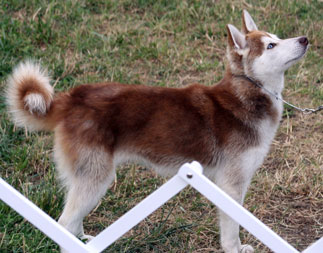Alaskan Klee Kai
The Alaskan Klee Kai is a northern breed of dog of spitz type. The breed was developed in the 1970s to create a companion sized dog resembling the Alaskan Husky (a mixed breed of dog used for sled racing), resulting in an energetic, intelligent, apartment-sized dog with an appearance that reflects its northern heritage. There are approximately 1500 Alaskan Klee Kais in the world.[2]
History
The breed was developed in Wasilla, Alaska, from the early 1970s to 1988 by Linda S. Spurlin and her family.[3] The breed was developed withSiberian and Alaskan Huskies using Schipperke and American Eskimo Dog to bring down the size without dwarfism. She bred these dogs in private until she released them to the general public in 1988. Originally called the "Klee Kai", the breed split into "Alaskan Klee Kai" and "Klee Kai" for political reasons in 1995. The breed consolidated under the new name in 2002. The Alaskan Klee Kai was officially recognized by the American Rare Breed Association (ARBA) in 1995 and by the United Kennel Club (UKC) on January 1, 1997.[4]
Appearance
Height and weight ranges
The Alaskan Klee Kai appears to be a small version of Siberian Husky but there are physical differences such as: a shorter muzzle, larger ears, and higher tail set, that make them easily distinguishable from the Siberian.
They come in three sizes based on their height:
- Toy size Alaskan Klee Kai are up to and including 33 cm (13 inches).
- Miniature Alaskan Klee Kai are over 33 cm high and up to 38 cm (15 inches) high.
- Standard Alaskan Klee Kai are over 38 cm high and up to 43 cm (17 inches) high.
- Serious Fault - Any Alaskan Klee Kai over 43 cm and up to 44,5 cm (17½ inches).
- Eliminating Fault* - Any Alaskan Klee Kai over 44,5 cm.
(*An Eliminating Fault is a Fault serious enough that it eliminates the dog from obtaining any awards in a conformation event.)
The three sizes of Alaskan Klee Kai also have different weight requirements:
- Toy size Alaskan Klee Kai are up to and including 9 pounds (4.1 kg).
- Miniature Alaskan Klee Kai are 10–15 pounds (4.5–6.8 kg).
- Standard Alaskan Klee Kai are 16–23 pounds (7.3–10 kg).
Coat and coloring
Alaskan Klee Kai come in three recognized color varieties: black and white, gray and white, or red and white (which may appear as a cinnamon or a dark auburn). Solid white Alaskan Klee Kai also exist but this coat color variety is considered a disqualification by the breed standard. Solid white Alaskan Klee Kai have just recently become recognized by the United Kennel Club and may be registered but not shown competitively.
There are also two coat types found in the Alaskan Klee Kai breed. These consist of the standard and full-coated varieties. Both are recognized by the UKC and equally acceptable by the breed standard. The only exception being that the coat length may not be so long as to obscure the outline of the dog, which is considered a breed fault.
The Alaskan Klee Kai, like the Siberian Husky, is relatively easy to care for. They are extremely clean. Most do not like wet feet and will spend hours daily grooming themselves. Alaskan Klee Kai, like many other northern breeds, do not have a typical "doggy odor" or "doggy breath." Most Klee Kai will seldom require a bath. They are rather efficient, so no grooming needed.
As in Siberians and unlike short haired dogs who shed all year long, the Klee Kai blows its coat twice a year. Of course, the size of the dogs limits the amount of fur blown. It is best to groom the dog on a regular basis during this time. Some of the longer haired dogs can become matted if not groomed. Most Klee Kai will assist the loss of hair by rubbing against things such as fences. Other than this period of blowing coat, the Klee Kai is very self-sufficient. The normal preventative measures should be taken, such as trimming of nails, normal grooming in the form of brushing. This process is especially important in the bonding process.
Temperament
The Alaskan Klee Kai is a highly intelligent, curious and active breed. Unlike Siberian Huskies, whom they closely resemble, Alaskan Klee Kai can be standoffish and cautious around unfamiliar individuals. Because of their inherently reserved disposition in the presence of strangers, continual socialization throughout an Alaskan Klee Kai's life is highly encouraged. They are moderately active and have a strong prey drive. This means unless they are properly introduced and raised with smaller animals such as rabbits, hamsters, cats and birds, they will hunt them.
They can be a great family dog if raised with young children who are careful with animals: Alaskan Klee Kai are not likely to tolerate being mistreated and should be monitored when with children. Because of their intelligence, they do well in obedience classes and have a high drive to please their owners which helps them to excel in this area as well as many other types of activities. Another such activity is agility in which the Alaskan Klee Kai almost seems to have been bred to take part in.
 | ||||||||||||||||||||||
| A Standard Sized Alaskan Klee Kai | ||||||||||||||||||||||
| Other names | Klee Kai | |||||||||||||||||||||
|---|---|---|---|---|---|---|---|---|---|---|---|---|---|---|---|---|---|---|---|---|---|---|
| Nicknames | AKK | |||||||||||||||||||||
| Country of origin | United States | |||||||||||||||||||||
| ||||||||||||||||||||||
| ||||||||||||||||||||||





No comments:
Post a Comment